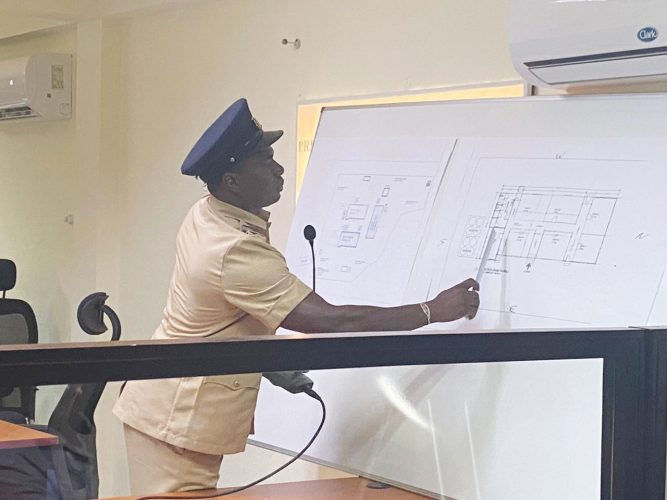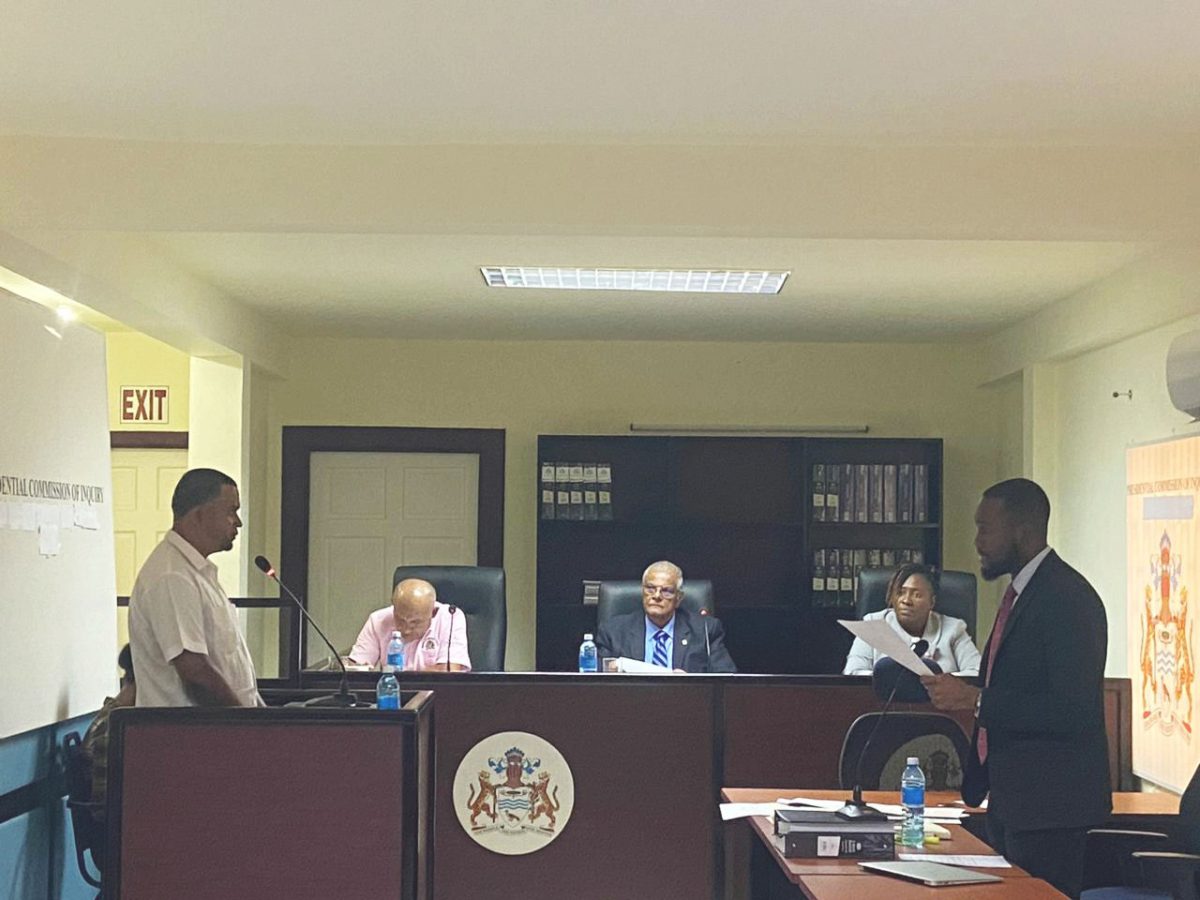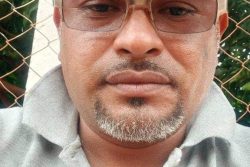By Adrian Dey
Although his after-action report suggested that proper fire-fighting equipment would have made the task easier for the GFS on the night of the tragic Mahdia dormitory blaze, Sub-officer Ryan Scott maintained that his team did their best given the circumstances.
Scott, who is stationed at the Mahdia Fire Station, yesterday informed the ongoing presidential Commission of Inquiry (CoI) into the tragedy that he and his staff who consisted of auxiliary fire-fighters were informed late of the inferno which claimed 20 lives. The Mahdia Fire Station, according to the officer, does not have a telephone and that communication is done through cellphone.
The inquiry was informed that officials from the Guyana Fire Service’s (GFS) central location in Georgetown had to inform fire officials in Mahdia of the burning building via cellphone.

He testified that the burning building was fully extinguished at 3 am due to challenges such as insufficient water supply from the fire truck, lack of fire hydrants at the female dormitory, and inadequate fire equipment, such as sledgehammers, self-breathing apparatus or masks, and cutting and welding tools.
CoI Commissioner Dr Kim Kyte-Thomas asked the sub-officer if he would still state that the operation was effective despite the lack of adequate fire equipment as stated in his after-action report.
Scott hesitated for roughly 4 minutes and responded yes. Kyte-Thomas was a bit taken aback by the answer as she felt that his testimony contradicted his statement which was outlined in his report.
She restructured the question and the Fire Service Officer replied that even if the fire-fighting team was well-equipped the circumstances would not have been different since they were late in their response to the fire.
Commission Counsel Keoma Griffith pressed, “Based on all the deficiencies [lack of water, basic fire gears, vehicular issues] you highlighted in your after-action report, sir, can you now say that they all have impeded the effectiveness of the Mahdia Fire Station on the night of the tragic fire which claimed 20 precious lives.”
Scott replied by saying he didn’t “ understand the question and if it can be rephrased.”
Though the CoI Counsel simplified the question Scott took a while to respond and then said that his team was effective, which was an eye-brow raiser for the inquiry.
The sub-officer disclosed that their alternative water source was from the nearby trenches. He recalled that auxiliary fire-fighters were at the time rendering assistance by retrieving the water from the trenches when they discovered that it was blocked.
Upon seeing the situation, Scott said he jumped into the trench and removed the obstacles causing the blockage.
He informed the commission of inquiry that while there were no fire hydrants at the female dormitory, hydrants were present at the Mahdia Secondary School.
Scott also replied in the affirmative, when the inquiry’s counsel asked if the presence of fire hydrants was not important considering the fact that in excess of 100 students resided at the dormitory.
Two-inch
Despite his recommendations to the GFS that this was needed, the stumbling block was the presence of a two-inch main as a four-inch main was needed to facilitate the installation of a fire hydrant.
Asked by the counsel if any efforts were made to inform his superiors of this challenge Scott replied in the positive but noted that the issue falls with the parameters of the Guyana Water Incorporated (GWI) and the Regional Democratic Council of Potaro-Siparuni (Region Eight).
“On numerous occasions it was brought to the attention of the regional democratic council since the police and army headquarters and several other schools have set up the same way with a two-inch main.”
“The placement of a two-inch main is what prevented the fire hydrants from being installed at the building [Mahdia secondary school female dorm] that all I can say sir”, the GFS Officer told the inquiry.
He however informed the commission that the community of Mahdia currently has sixteen fire-hydrants.
Commission Chairman, Major General (retired) Joe Singh asked if the fire service conducted a meeting following the inferno on a contingency plan in case of a recurrence to which Scott said that discussions were held between the RDC and GFS in that regard.
He made it clear that concerns were raised about the Mahdia Fire Service’s minimal human and financial resources but there were no in-depth discussions in relation to a contingency plan in event of a fire.
He also told the commission that when the fire service arrived 14 bodies were burnt beyond recognition
According to him 10 of the 14 bodies were in a room which stored solar panels.
Based on site inspections done by him and his team, they discovered a burnt washing machine and mattresses. The inspection also revealed lack of fire alarms, and smoke detectors in the building.
He also recalled recommendations for removing grills from the dormitory windows, ensuring all exit doors are easily accessible, suitable display of exit signs and instructions throughout the building in event of a fire.
Additionally, Scott told the inquiry that it was recommended for all employees at the dormitory to be trained in the use of fire prevention equipment and evacuation.
Meanwhile Inspector Krishna Seetaram of the Mahdia Police Station in his emotional testimony said that he witnessed a few of the burnt bodies.
He said that on the night of the incident he spoke with both male and female dorm wardens of the dormitory, the headteacher, and a few school children, to ascertain what transpired.
Seetaram, who was also head of the Criminal Investigation Department (CID) at the police station, confirmed that a police report was compiled and sent to the Director of Public Prosecutions (DPP) for further examination.
The inspector tearfully testified that he was at the Georgetown Public Hospital the following day with families of the deceased fire victims along with ministers of government.
He informed the inquiry of being granted the opportunity to witness six of the post-mortem examinations conducted by Dr Nehaul Singh (Chief Pathologist) at the public hospital.
The police official told the inquiry that 14 bodies were badly burnt.
Seetaram also informed the inquiry of being present at the court proceedings of the school girl accused of setting the dorm ablaze.
According to the inspector he was there when the accused appeared before Magistrate Sunil Scarce at the Mahdia Magistrate’s Court where 20 charges of murder were read to her.
Like the Mahdia Fire Station, the community’s police station doesn’t have telephones and the alternative mode of communication is via cellphone. Seetaram confirmed.
The hearing continues today at 10 am.





